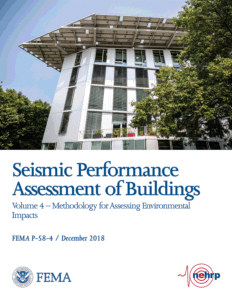Des fins de recherche:
Développer une base de données complète sur la réparation des composants structurels et non structurels des bâtiments
À propos
En évaluant la impacts environnementaux du cycle de vie des bâtiments, the contributions of seismic damage are rarely considered. This project developed and analyzed the largest known environmental impact database of building component seismic damage. By extending established methods of probabilistic seismic performance evaluation to include environmental impacts, a more comprehensive assessment of a building’s expected seismic performance can be evaluated.
To calculate the environmental impacts, data from Carnegie Mellon University’s Green Design Institute’s Economic Input-Output Life Cycle Analysis (LCA) database were connected to previously established repair cost estimate data. Environmental impacts, including embodied carbon, embodied energy, and other metrics, were calculated for the repair of nearly 800 building components under three or more different seismic damage levels. This database was developed to support the Federal Emergency Management Agency’s (FEMA) Performance Assessment Calculation Tool (PACT) as a part of Projet FEMA P-58.
Résultats
Travaux d'évaluation environnementale pour FEMA P-58 peuvent être trouvés dans:
- FEMA-P-58-4: «Volume 4 - Méthodologie d'évaluation des impacts environnementaux»
- Documentation de base, Section 3.7.20: «Méthodologie d’évaluation de l’impact sur l’environnement» (fichier zip)
Publications de revues
- Simonen, Huang, Aicher et Morris. (2018). Carbone incorporé comme indicateur de l'impact environnemental de la réparation des dommages causés par le tremblement de terre. Énergie et bâtiments.
- Huang et Simonen. (2020). Analyse environnementale comparative des dommages sismiques dans les bâtiments. Journal of Structural Engineering.
Équipe de recherche
- K. Simonen (UW), PI
- M. Huang (UW)
- P. Morris (AECOM)
Remerciements
Ce matériel est basé sur des travaux financés par l'Agence fédérale de gestion des urgences et gérés par le Conseil de la technologie appliquée (ATC) dans le cadre du projet ATC 58-2, dont le contenu est dédié au public. Les opinions, constatations et conclusions ou recommandations exprimées dans le matériel sont celles des auteurs et ne reflètent pas nécessairement les vues de l'Agence fédérale de gestion des urgences ou du Conseil de la technologie appliquée.
Additional contributions from John Hooper, Anthony Court, Wayne Trusty, Mark Webster, and Jon Heinz. We thank Chris Aicher and Professor Paul Sampson from the Department of Statistics at the University of Washington for their assistance and advisement in the statistical component of this work. We also thank Ibrahim Almufti, his team at ARUP, and Kristen Strobel, a graduate student at the University of Washington, for their work in providing the data for the case study building as well as H. Scott Matthews at Carnegie Mellon University for his advice regarding the use of their EIO LCA database.
We would also like to acknowledge John Gillengerten, who developed the PACT model files for the case study buildings and provided guidance on their use; Vesna Terzic, who evaluated the case study buildings during their development; Scott Hagie and Russell Larson, who provided additional support for the PACT software; and Ayse Hortacsu for additional information about PACT.
